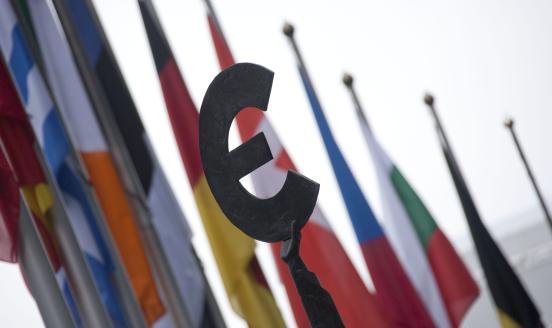Which way for Europe?
August was quieter than feared on the European bond markets. While resting on Europe’s celebrated beaches and mountains, policymakers could therefore
August was quieter than feared on the European bond markets. While resting on Europe’s celebrated beaches and mountains, policymakers could therefore take a step back from the sound and fury of the last few months and think about the future. Is the euro area sleepwalking into the United States of Europe? Is it exploring unchartered territory? Or are its constituent nation states drifting apart?
To answer these questions, the best starting point is the US. The model of a federal union that emerged from its history consists of a single currency managed by a federal agency; closely integrated markets for products, labour and capital; a federal budget that partially, but automatically offsets economic disturbances affecting individual states; a federal government that in addition takes responsibility for tackling major risks – not least those emanating from the banking sector; and states that provide regional public goods but play virtually no macroeconomic stabilisation role.
This model served as a template for the architects of the EU, notably on the creation of a unified market and a common currency. But, in several respects, Europe has diverged significantly from the American template.
First and foremost, it has not built a federal budget. Back in the 1970s, it was still hoped that common spending would eventually amount to 5 to 10 per cent of its GDP, but this dream never started to materialise. In proportion of GDP, the EU’s budget is no larger today than thirty years ago: a meagre 1 per cent. Furthermore its resources are essentially contributions from national treasuries, rather than federal taxes.
An important reason for this is that unlike in the US, where federal public spending grew as a consequence of the creation of new expenditure programmes throughout the 20th century, public spending was already high at national level when Europe started to integrate. Significant federal spending programmes could only have emerged from the transfer of existing national programmes to the European level. Not surprisingly, and such transfers were unsurprisingly resisted.
The euro area more recently has started creating a system of mutual insurance among participating states. Since 2010 assistance has been extended to Greece, Ireland, Portugal and now Cyprus. Spain is set to receive support also, with a particular focus on the banking sector. So a specific pattern is emerging: states help each-other.
But solidarity is not free: first, it is conditional on beneficiaries having signed on to a fiscal treaty that commits them to budgetary responsibility and makes them liable to quasi-automatic sanctions; second, any assistance is conditional on the implementation of negotiated measures and a close monitoring of policy developments. In other words the price for solidarity is limited sovereignty.
Unlike in America, national governments and, increasingly, their parliaments, are calling the shots. As assistance does not rest on federal resources but on the pooling of national ones, creditor states inevitably demand more power in exchange for more support to their neighbours. As a result, currency unification has not brought Europe closer to the US; on the contrary, it has pushed it in a different direction.
In the US the federal government first acts as an overall shield against common risks; then it provides unconditional automatic support to states in trouble; but, in the end, it does not come to the rescue of a defaulting state, nor does it take over its government. In Europe, by contrast, there is almost no aggregate shield, there is almost no automatic support for member states in trouble, but etter-off states extend a conditional helping hand to prevent default.
The politics of this model are quite different too. In the US states compete for power with the centre, in Europe they increasingly compete for it with each-other. All federations have gone through periods of tense relationships between the federal and the state governments. But to accept that your neighbours look over your shoulders and dictate to you what to do is one degree more dreadful than to accept oversight from the centre. In Greece people don’t blame Brussels for the harsh adjustment they are going through, but rather Berlin.
A major problem with the current state of affairs is indeed the weakness of institutions that are in charge of speaking for the common interest and that are accountable to Europeans as a whole. The European Commission is in principle in charge of the common European interest, but it has been given a limited role in the new assistance framework. It is involved in defining the conditionality of assistance but has no role in its provision. The European Central Bank is a strong institution, but its remit is narrow. The European Parliament is not in charge of monitoring the use of assistance resources, since these resources do not come from, or rely on common taxes. However common directions cannot lastingly emerge from the mere calculus of national interests by national governments and parliaments that are accountable only to national voters. So like a house in construction, the system remains incomplete.
Which way is Europe going to go? The big question to which nobody has a clear answer is whether Europe is in the process of inventing a model of its own or whether it has only taken a detour from the inevitable choice between disaggregation and convergence on the standard federal template. In the first case one could for example imagine providing to national representatives a venue where they could socialise and hold European-wide debates. This assembly would help overcome strict national biases and contribute to the emergence of cross-national cleavages. But another solution would be to transfer the insurance role to a federal institution accountable to the European parliament. This would imply giving to the centre the power to raise taxes and would lead to the building of a federation.
Whatever the route it takes, however, Europe in the years to come will have to address the weak representation of the common interest. The debate on this issue cannot be postponed for very long anymore.
A version of this article was also published in Project Syndicate and Caixin



